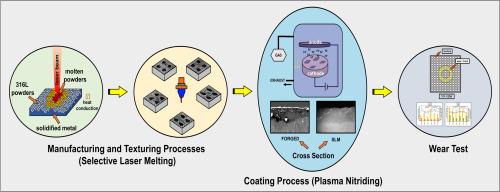Surface & Coatings Technology ( IF 5.3 ) Pub Date : 2020-07-10 , DOI: 10.1016/j.surfcoat.2020.126178 H. Kovacı , Y. Seçer

|
Surface texturing, which depends on the formation of different patterns on materials, is used to improve the tribological performance of materials. Therefore, the effects of different surface textures fabricated by selective laser melting (SLM) and plasma nitriding on the friction and wear properties of AISI 316L stainless steel were investigated in this study. AISI 316L samples with hexagonal, random, ellipse, triangle, square and the new model (ellipse+triangle) surface textures (patterns) were produced by SLM and they were plasma nitrided at 400 °C for 2 h. Tribological behavior of them was determined by a pin-on-disc type tribo-tester under dry and simulated body fluid (SBF) conditions. XRD, SEM, microhardness tester and 3D surface profilometer were used for characterizations. The results showed that the surface textures and their area density were highly effective on the friction and wear properties and the increasing area density provided better wear resistance. Ellipse geometric pattern had the lowest friction coefficient and wear rate because it trapped wear debris and provided a smooth stress transition in comparison to the sharp-edged textures by enabling hydrodynamic benefit. Plasma nitriding led to decrease friction coefficient and wear rate for all surface textures since it produced a hard compound layer. Also, the best results were obtained from SBF because solid-solid contact was prevented and wear debris was removed by solution.
中文翻译:

通过组合表面处理提高AISI 316L不锈钢的摩擦学性能:通过选择性激光熔化和等离子渗氮进行表面纹理化
表面纹理化取决于材料上不同图案的形成,用于改善材料的摩擦学性能。因此,本研究研究了选择性激光熔化(SLM)和等离子渗氮制造的不同表面织构对AISI 316L不锈钢的摩擦磨损性能的影响。通过SLM生产具有六角形,随机,椭圆形,三角形,正方形和新模型(椭圆+三角形)表面纹理(图案)的AISI 316L样品,并将其在400°C下进行等离子体氮化2 h。在干燥和模拟体液(SBF)条件下,通过针式盘式摩擦测试仪确定了它们的摩擦学行为。使用XRD,SEM,显微硬度测试仪和3D表面轮廓仪进行表征。结果表明,表面织构及其面积密度对摩擦和磨损性能非常有效,面积密度的增加提供了更好的耐磨性。椭圆形几何图案具有最低的摩擦系数和磨损速率,因为与锐利边缘的纹理相比,椭圆形几何形状可以捕获磨损碎片并提供平滑的应力转换,从而具有流体动力学优势。等离子体渗氮会降低所有表面纹理的摩擦系数和磨损率,因为它会产生坚硬的化合物层。同样,从SBF获得最佳结果是因为可以防止固-固接触,并且可以通过溶液去除磨损碎屑。椭圆形几何图案具有最低的摩擦系数和磨损速率,因为与锐利边缘的纹理相比,椭圆形几何形状可以捕获磨损碎片并提供平滑的应力转换,从而具有流体动力学优势。等离子体渗氮会降低所有表面纹理的摩擦系数和磨损率,因为它会产生坚硬的化合物层。同样,从SBF获得最佳结果是因为可以防止固-固接触,并且可以通过溶液去除磨损碎屑。椭圆形几何图案具有最低的摩擦系数和磨损速率,因为与锐利边缘的纹理相比,椭圆形几何形状可以捕获磨损碎片并提供平滑的应力转换,从而具有流体动力学优势。等离子体渗氮会降低所有表面纹理的摩擦系数和磨损率,因为它产生了坚硬的复合层。同样,从SBF获得最佳结果是因为可以防止固-固接触,并且可以通过溶液去除磨损碎屑。











































 京公网安备 11010802027423号
京公网安备 11010802027423号